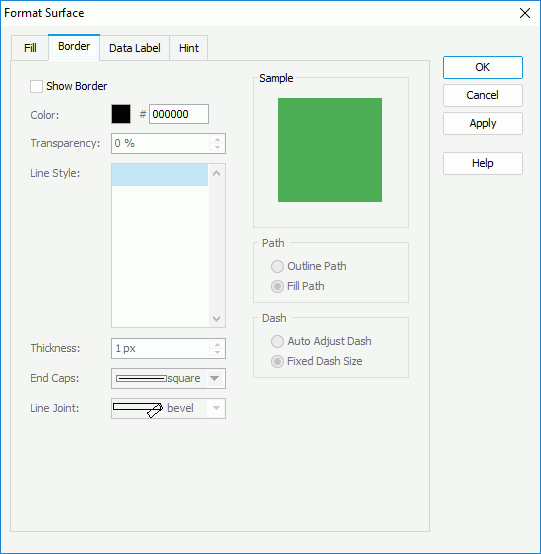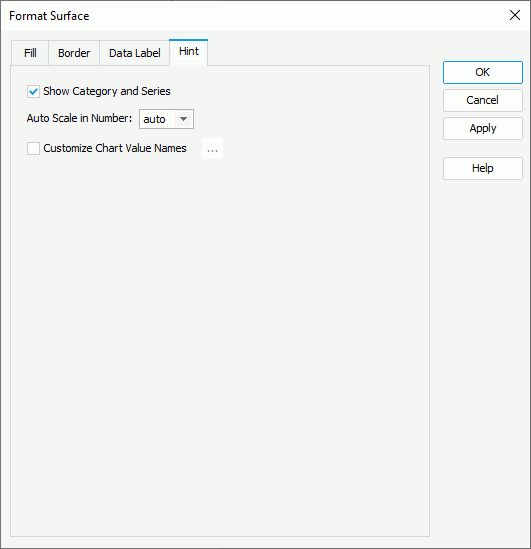Format Surface Dialog Box
You can use the Format Surface dialog box to format the surface in a surface chart. This topic describes the options in the dialog box.
Designer displays the Format Surface dialog box when you right-click a vertex in a surface chart and select Format Surface from the shortcut menu, or double-click a vertex in a surface chart.
This dialog box contains the following tabs:
Designer displays these buttons in all the tabs:
OK
Select to apply your settings and close the dialog box.
Cancel
Select to close the dialog box without saving any changes.
Apply
Select to apply all changes and leave the dialog box open.
Help
Select to view information about the dialog box.
Fill Tab
Use this tab to specify the fill pattern of the range sections in the surface chart.

Color
Specify the color of the selected range sections in the same data series. To edit the color, select the color indicator and select a color from the color palette, or type the hexadecimal RGB value of a color (for example, 0xff0000) in the text box.
Transparency
Specify the transparency of the color.
Self Settings
Select to apply the color pattern to the range sections themselves. When this option is cleared, the color settings defined here will be synchronized to the Pattern List property on the chart object in the Report Inspector, which can also be applied by data markers of other subtypes when the chart is a combo chart.
Color List
Select to open the Color List dialog box to modify the color pattern for the range sections in the same data series respectively.
Sample
This box displays a preview sample based on your selections.
Border Tab
Use this tab to specify properties for the border of the range sections in the surface chart.

Show Border
Select to show the border of the range sections. Designer enables the other border properties in this tab after you select this option.
Color
Specify the color of the border. To edit the color, select the color indicator and select a color from the color palette, or type the hexadecimal RGB value of a color (for example, 0xff0000) in the text box.
Transparency
Specify the transparency of the border.
Line Style
Select the line style of the border.
Thickness
Specify the width of the border, in pixels.
End Caps
Select the ending style of the border.
- butt
Select to end unclosed subpaths and dash segments with no added decoration. - round
Select to end unclosed subpaths and dash segments with a round decoration that has a radius equal to half of the line width. - square
Select to end unclosed subpaths and dash segments with a square projection that extends beyond the end of the segment to a distance equal to half of the line width.
Line Joint
Select the joint style of the border.
- miter
Select to join path segments by extending their outside edges until they meet. - round
Select to join path segments by rounding off the corner at a radius of half the line width. - bevel
Select to join path segments by connecting the outer corners of their wide outlines with a straight segment.
Sample
This box displays a preview sample based on your selections.
Path
You can specify the fill pattern of the border in this box.
- Outline Path
Select to use outline path for the border. - Fill Path
Select to use whole path for the border.
You can specify the dash size of the border in this box if you select a dash line style for the border.
- Auto Adjust Dash
Select to adjust the dash size automatically. - Fixed Dash Size
Select to use fixed dash size.
Data Label Tab
Designer does not support displaying data labels in surface charts, so you can skip in this tab.

Hint Tab
Use this tab to specify properties for the hint of the surface chart.

Show Category and Series
Select to include the category and series values in the hint.
Auto Scale in Number
Specify whether to automatically scale the Number values in the hint that fall into the two ranges:
- When 1000 <= value < 10^15, Designer applies the following quantity unit symbols of the International System of Units to scale the values: K (10^3), M (10^6), G (10^9), and T (10^12).
- When 0 < value < 0.001 or value >= 10^15, Designer uses scientific notation to scale the values.
By default, Designer selects "auto" for the option, meaning, Designer applies the setting that you specify for the same property on the chart in the Report Inspector for the values. If you select "true", Designer applies the specified format to the integer part of the values after scaling them; however, if the specified format conflicts with the logic of Auto Scale in Number, for example, the values display in percentage, Designer ignores the Auto Scale in Number setting. Select "false" if you do not want to scale the values.
Customize Chart Value Names
Select to customize the names of the fields on the value axis which you want to display in the hint. By default, Designer applies the display names of the fields in the hint to label the values which may be not intuitive to users. You can select the option and select the ellipsis  to customize the names in the Customize Chart Value Names dialog box to help users better understand the values.
to customize the names in the Customize Chart Value Names dialog box to help users better understand the values.
 Previous Topic
Previous Topic
 Back to top
Back to top